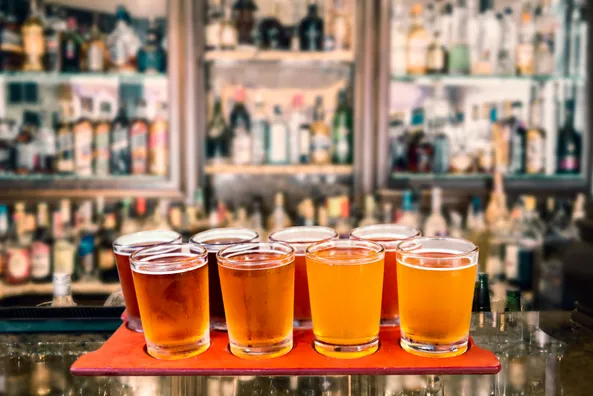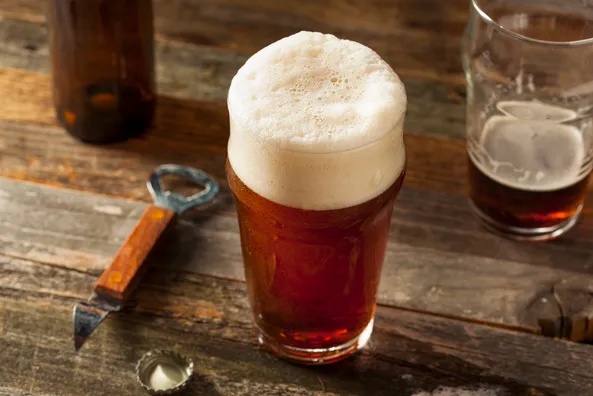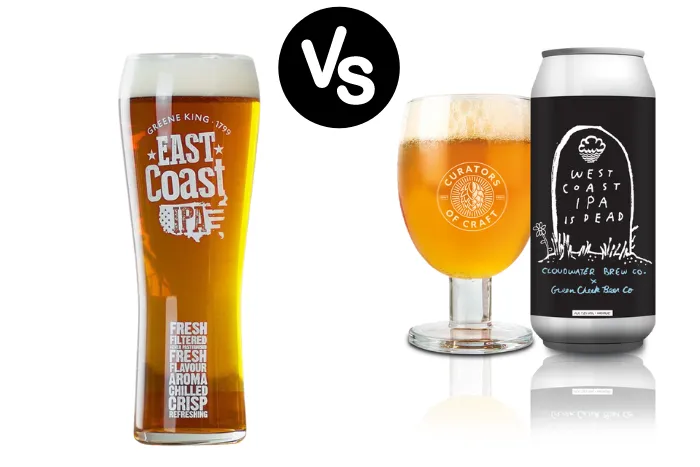It’s no secret that there are significant differences between West Coast IPA and East Coast IPA. From the brewing process to taste, color, alcohol content, and calorie count – what makes each style unique? In this blog post, we’ll explore the history of both types of IPAs, their different brewing processes, ingredients used in production, famous examples from each coast, and more! By understanding these distinctions, you can better appreciate why West Coast IPA vs. East Coast IPA is such a hot topic among beer enthusiasts worldwide.
Table of Contents:
- History of West Coast IPA and East Coast IPA
- Brewing Process of West Coast IPA vs East Coast IPA
- Popular Examples of West Coast IPAs and East Coast IPAs
- Conclusion
History of West Coast IPA and East Coast IPA

The origin of West Coast IPA dates back to the late 1980s when American craft brewers began experimenting with bolder, hoppier beers. This style was created in response to the light lagers that dominated the market then and quickly gained popularity among beer drinkers looking for something new and exciting.
West Coast IPAs are characterized by intense hop bitterness, floral aroma, and firm malt backbone. They typically have a higher alcohol content than other beer styles and can range from golden amber to deep copper.
Origin of East Coast IPA is rooted in British brewing traditions. Still, it has been adapted by American craft brewers who wanted to create an even more flavorful version of this classic style. East Coast IPAs tend to be less bitter than their West Coast counterparts.
However, they still have a lot of hop flavor and notes of citrus or tropical fruit from the hops added during fermentation or dry hopping. These beers also tend to be lighter in color than traditional English IPAs and often have a slightly sweeter finish due to increased residual sugars left behind after fermentation.
West Coast IPA and East Coast IPA have been around for decades, but their brewing processes have evolved. Now let’s look at the differences in ingredients used and brewing process between West Coast and East Coast IPAs.
Brewing Process of West Coast IPA vs East Coast IPA

Ingredients Used in West Coast IPA:
West Coast IPAs are typically brewed with pale malts and hops. This style’s most common hop varieties include Cascade, Centennial, Chinook, Columbus/Tomahawk/Zeus (CTZ), Simcoe, Amarillo, Citra, and Mosaic.
These hops impart flavors of citrusy fruitiness and piney bitterness to the beer. In addition to these hops, some brewers use specialty grains such as Munich or crystal malt to add complexity and body to the beer.
Ingredients Used in East Coast IPA:
East Coast IPAs are generally brewed with a combination of pale malts and American-grown hops like Cascade or Centennial. However, they tend to be less hoppy than their West Coast counterparts because they use fewer hop varieties overall.
Some brewers may also choose English hops like Fuggles or Goldings, which have more subtle earthy notes than the strong fruity smells of West Coast IPAs. Additionally, some brewers will add specialty grains such as Vienna malt or CaraPils malt for added depth of flavor and mouthfeel.
Overall, West Coast IPAs and East Coast IPAs differ significantly in brewing. Although they are both hop-forward beer styles, the types of hops used and other ingredients, such as yeast and malts, can create vastly different flavor profiles. Let’s look at some famous regional examples to better understand these differences.
Popular Examples of West coast IPAs
West Coast IPAs are known for their bold hop flavor and aroma, often accompanied by a firm bitterness. Some famous examples of West Coast IPAs include Sierra Nevada’s Torpedo Extra IPA, Stone Brewing Co.’s Ruination IPA, Lagunitas’ Hop Stoopid Ale, and Deschutes Brewery’s Fresh Squeezed IPA. These beers typically have an ABV (alcohol by volume) between 6-7% and feature intense aromas of citrusy hops such as Cascade or Centennial.
Popular Examples of East coast IPAs
East Coast IPAs are characterized by their maltier taste profile with a more subtle hop presence than their West Coast counterpart. Notable examples include Dogfish Head’s 60 Minute IPA, Founders Brewing Company’s All Day IPA, Bell’s Two Hearted Ale from Michigan, and Harpoon Brewery’s UFO White from Massachusetts. These beers usually have an ABV of 4-6%, focusing on balance rather than extreme hoppiness like the West Coast style.
Both West coast and East coast IPAs offer a variety of unique flavors that appeal to different beer enthusiasts. The following section will discuss our conclusion on which IPA style is superior.
Frequently Asked Questions
How do the hop profiles of West Coast IPAs compare to those of East Coast IPAs?
West Coast IPAs tend to have a higher hop presence than East Coast IPAs, producing more intense aromas and flavors. West Coast IPAs often feature citrusy notes such as grapefruit or orange peel. At the same time, East Coast IPAs may be characterized by floral or herbal characteristics.
Generally, the hops used in West Coast beers are more assertive and bolder than those used on the East Coast. However, there are still a lot of differences between the styles of IPA from each coast. Regarding bitterness level, West Coasts tend to range from medium-high to high IBUs (International Bitterness Units). In contrast, East Coasts generally fall into the lower end of that spectrum.
Does one style of IPA have more bitterness than the other?
One style of IPA can have more bitterness than another. The amount of bitterness in an IPA depends on the type and quantity of hops used and how long they are boiled. Some IPAs may contain additional ingredients, such as fruit or spices, that can contribute to a beer’s overall flavor profile. Ultimately, it comes down to personal preference and experimentation with different recipes to determine which style has more bitterness.
What are the main differences between West Coast IPAs and East Coast IPAs?
West Coast IPAs are typically hop-forward, with a firm bitterness and citrusy flavor. They have higher alcohol content and tend to be lighter in the body. East Coast IPAs generally use maltier malts that give them a sweeter caramel taste.
These beers are less bitter than West Coast IPAs. Still, they usually have an equal or more significant ABV (alcohol by volume). East Coast IPAs often feature earthy aromas such as pine and grass due to the hops used in their brewing process.
Both styles of IPAs are popular among craft beer enthusiasts. Still, they offer different flavor profiles that appeal to different palates.
Conclusion
The West Coast IPA and East Coast IPA are two distinct styles of India Pale Ale that have developed over the years. The West Coast style has a strong hop presence, intense bitterness, and a dry finish. It is often brewed with Cascade hops for its citrusy flavor profile. On the other hand, the East Coast style has a more balanced malt-hop ratio with less bitterness and a sweeter finish due to the use of English hops such as Fuggles or Goldings.
Overall, both styles offer unique characteristics that appeal to different beer drinkers. Whether you prefer one or the other depends on your taste preferences. Still, both styles are enjoyable in their own right.
Are you ready to explore the world of craft beer? Are you curious about the differences between West Coast and East Coast IPAs? Do you want to learn more about home brewing or what subscription services are available for beer lovers? Look no further!
Also See: How Many Coors Light To Get Drunk? A Comprehensive Guide

